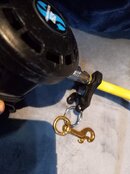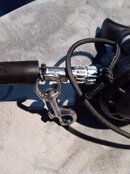Retainer Types
Long Hose - A long, often 7ft hose is routed around the neck and shoulder area in a specific way. No additional retainers are needed, as it becomes difficult to lose. Typically, this configuration is done by technical divers, and you'll get training in those courses. Or you can find videos showing how to do it on YouTube. I personally find this setup a little complicated, and probably wouldn't start here.
Silicone Necklace - Search "silicone scuba necklace" on ebay or elsewhere. The smaller circular part goes over your mouthpiece, and the main loop goes around your neck. Personally, I find the regulator can slip out, and the necklace itself is a little annoying when donning gear. You could potentially zip-tie it to the mouth-piece area of your regulator to prevent it from slipping off. (big yellow loop in top photo)
These can be a choking/entanglement hazard, however it also looks like there are newer version than the one I posted above, that can "breakaway."
Bungie Necklace - Ensure your mouthpiece is very secure on your regulator (usually with a ziptie), and not easily pulled off. I'd recommend replacing your zip-tie with a nice sturdy/thick one and getting it nice and tight to be sure.
Take a length of bungie-cord (shock cord) about 3/8in to 10mm, tie a knot on each end. Place each end of your length of bungie on the left and right side of the mouthpiece, wrap another zip-tie around the mouthpiece and 2 ends of bungie. The tightness of this zip-tie should allow the bungie to be pulled in either direction to shorten or lengthen the necklace, while also providing enough resistance it doesn't slip easily.
Do not use a single zip-tie to secure both the necklace and mouthpiece, as you risk pulling off the mouthpiece!
This is one of my personal favorites, and one I use, because it's very secure, and when tightened, you can make it "impossible" for your regulator to fall out, such as in a temporary loss of consciousness scenario, or just simply your jaw getting tired. The downside is whatever regulator is on a necklace isn't easily donated. This can either be used for your primary 2nd stage
(the one you mostly breathe from), or your octo/pony if you intend to primary-donate.
(right side below. Not the greatest photo, it's what I have available at the moment. Notice a white and a black zip-tie.)
Ring and Clip
This style is decent for clipping an octo regulator to your BCD. The mouthpiece is inserted into the loop. When deploying a simple tug will free the regulator from the loop.
The downside is inserting the regulator back in this ring underwater is a pain, and that clip isn't really designed to be operated underwater.
(small yellow and blue retainers in top photo)
Mouthpiece Covers & Inserts
I hate all of these. Inserting a mouthpiece can be a pain, and then can slip out easily. These have all the problems of the "Ring and Clip" version, but are much worse. At minimum try the "Ring and Clip" version first.
Hose-Magnet
Search for "scuba regulator magnet"
These work, and can be ok, especially if you intend to deploy and use your octo. They go around your hose on one side, and the other clips to a d-ring. The magnets are often not as strong as I prefer. I wish I could recommend a specific brand. I sometimes have these in addition to the "bolt snap breakaway" so I can re-stow the hose, if the o-ring breaks.
Hose Clip

This clips around your hose, and it's "breakaway" meaning you can free your regulator from your BCD and clip with a tug. By default they come with a clip I hate (see top photo). A slight disadvantage of this style is the hose may slip out when you don't want it to occasionally.
Boltsnap Breakaway

Take a small o-ring, zip-tie, and boltsnap. Insert o-ring through bolt-snap's loop, and wrap that around those hose. Secure the 2 sides of the o-ring to eachother using a zip-tie.
I suggest doing a test "breakaway" by attaching this to a d-ring, and giving it a sharp pull to make sure the o-ring breaks with moderate but not too significant force.
(and of course replacing the o-ring and zip-tie) You want it to breakaway in an emergency, and not be forced to fumble with a clip when you (or your buddy) need air now. In non-emergencies, you'll simply un-clip it to use, and re-clip it when done.
This design is great for sidemount, or any configuration where you'll frequently swap regulators. Typically, this is clipped to a d-ring on your chest, slightly below your collar-bone, but you can clip it wherever works for you. This is also one of my favorites, and one I use regularly. Carrying a couple zip-ties in a pocket while diving can also be useful for a variety of things
(that I won't cover here), including re-securing the regulator if the breakaway is broken.





